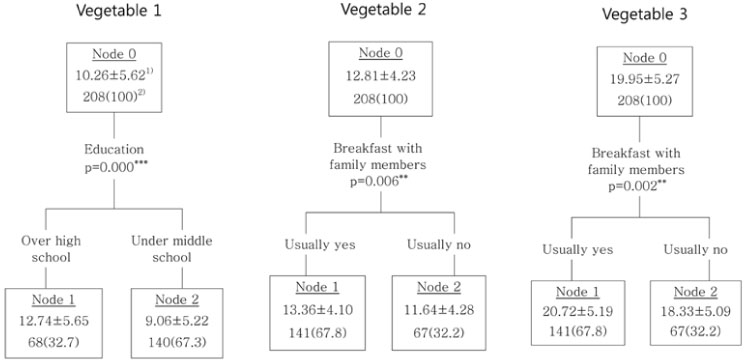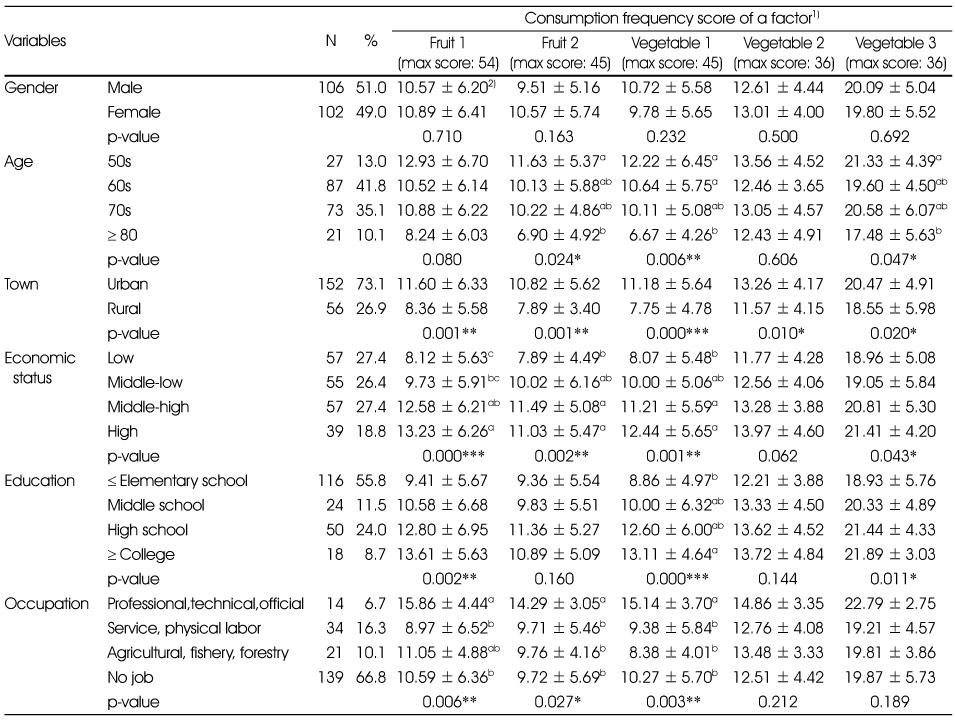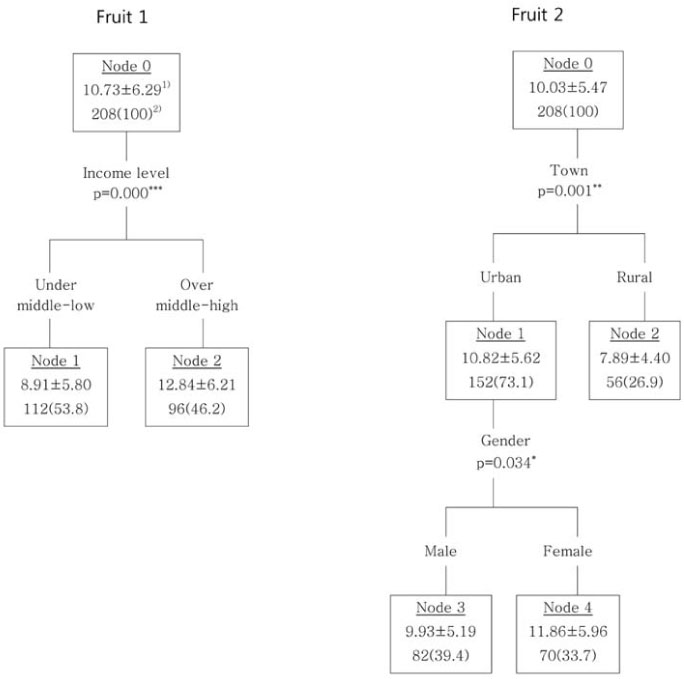Articles
- Page Path
- HOME > Korean J Community Nutr > Volume 19(5); 2014 > Article
-
Research Article
- Factors Associated with Fruit and Vegetable Consumption of Subjects Having a History of Stroke: Using 5th Korea National Health and Nutrition Examination Survey (2010, 2011)
- Sung Je Kim, Mi-Kyung Choi
-
Korean Journal of Community Nutrition 2014;19(5):468-478.
DOI: https://doi.org/10.5720/kjcn.2014.19.5.468
Published online: October 31, 2014
1)Department of Neurology, CHA Gumi Medical Center, CHA University, Gumi, Korea.
2)Department of Food and Nutrition, Keimyung University, Daegu, Korea.
- Corresponding author: Mi-Kyung Choi. Department of Food and Nutrition, Keimyung University, 1095, Dalgubeol-daero, Daegu 704-701, Korea. Tel: (053) 580-5872, Fax: (053) 580-5885, mkchoi@kmu.ac.kr
Copyright © 2014 The Korean Society of Community Nutrition
This is an Open-Access article distributed under the terms of the Creative Commons Attribution Non-Commercial License (http://creativecommons.org/licenses/by-nc/3.0/) which permits unrestricted non-commercial use, distribution, and reproduction in any medium, provided the original work is properly cited.
- 1,236 Views
- 8 Download
- 5 Crossref
Abstract
-
Objectives
- Intake of fruits and vegetables has protective effects against stroke attack. This study intended to examine the status of consuming fruits and vegetables and to find out which factors may influence the frequency of consumption of fruits and vegetables in individuals with a history of stroke.
-
Methods
- The data of 208 subjects from 5th (2010, 2011) Korea National Health and Nutrition Examination Survey (KNHNES) who reported a stroke diagnosis was used for analysis. To identify major factors influencing the consumption of fruits and vegetables, a classification-tree analysis was carried out.
-
Results
- Among those who reported a stroke diagnosis, the frequencies of consumption of fruits and vegetables were influenced by their age, place of residence (urban or rural), economic status, educational level, occupation, number of family members, frequency of eating out, and having meals (breakfast or lunch) with family members. Two factors from fruits and three factors from vegetables were generated by exploratory factor analyses. Urban residents ate fruits and vegetables more frequently in all factors than rural residents. Eating frequencies of 'seasonal fruits (orange, apple, strawberry, melon, pear and watermelon)', 'easily-accessible fruits (persimmon, tangerine, grape, peach, banana)', and 'Western-style vegetables (cabbage, mushroom, carrot, tomato, spinach)' were influenced by the socioeconomic status. Eating frequencies of 'Korean-style vegetables (bean sprout, radish leaves, pumpkin/squash, sea weed)', 'preserved vegetables (Korean cabbage, radish, laver, cucumber)' were influenced by having breakfast with amily members.
-
Conclusions
- The results of this study suggested that by eating more fruits and vegetables, more preventive effects against secondary stroke attack are expected in stroke patients who live in the rural areas and who do not eat breakfast with family members. In addition, more outreach and education programs are needed for them.
- 1. Addo J, Ayerbe L, Mohan KM, Crichton S, Sheldenkar A, Chen R, Wolfe CD, McKevitt C. Socioeconomic status and stroke: an updated review. Stroke 2012; 43(4): 1186-1191.ArticlePubMed
- 2. Avendaño M, Kunst AE, Huisman M, LentheFV , Bopp M, Borrell C, Valkonen T, Regidor E, Costa G, Donkin A, Borgan JK, Deboosere P, Gadeyne S, Spadea T, Andersen O, Mackenbach JP. Educational level and stroke mortality: a comparison of 10 European populations during the 1990s. Stroke 2004; 35(2): 432-437.ArticlePubMed
- 3. Cahill LE, Chiuve SE, Mekary RA, Jensen MK, Flint AJ, Hu FB, Rimm EB. Prospective study of breakfast eating and incident coronary heart disease in a cohort of male US health professionals. Circulation 2013; 128(4): 337-343.ArticlePubMedPMC
- 4. Cox AM, McKevitt C, Rudd AG, Wolfe CD. Socioeconomic status and stroke. Lancet Neurol 2006; 5(2): 181-188.ArticlePubMed
- 5. Dauchet L, Amouyel P, Dallongeville J. Fruit and vegetable consumption and risk of stroke: a meta-analysis of cohort studies. Neurology 2005; 65(8): 1193-1197.ArticlePubMed
- 6. De Gregorio J, Lee JW. Education and income inequality: new evidence from cross-country data. Rev Income Wealth 2002; 48(3): 395-416.Article
- 7. Farshchi HR, Taylor MA, Macdonald IA. Deleterious effects of omitting breakfast on insulin sensitivity and fasting lipid profiles in healthy lean women. Am J Clin Nutr 2005; 81(2): 388-396.PubMed
- 8. Fjellström K. Mealtime and meal patterns from a cultural perspective. Scand J Nutr 2004; 48(4): 161-164.Article
- 9. Fung TT, Chiuve SE, McCullough ML, Rexrode KM, Logroscino G, Hu FB. Adherence to a DASH-Style diet and risk of coronary heart disease and stroke in women. Arch Intern Med 2008; 168(7): 713-720.ArticlePubMed
- 10. Fung TT, Rexrode KM, Mantzoros CS, Manson JE, Willett WC, Hu FB. Mediterranean diet and incidence of and mortality from coronary heart disease and stroke in women. Circulation 2009; 119(8): 1093-1100.ArticlePubMedPMC
- 11. Fung TT, Stampfer MJ, Manson JE, Rexrode KM, Willett WC, Hu FB. Prospective study of major dietary patterns and stroke risk in women. Stroke 2004; 35(9): 2014-2019.ArticlePubMed
- 12. He FJ, Nowson CA, MacGregor GA. Fruit and vegetable consumption and stroke: meta-analysis of cohort studies. Lancet 2006; 367(9507): 320-326.ArticlePubMed
- 13. He K, Song Y, Daviglus ML, Liu K, Van Horn L, Dyer AR. Fish consumption and incidence of stroke: a meta-analysis of cohort studies. Stroke 2004; 35(7): 1538-1542.ArticlePubMed
- 14. Irala-Estévez JD, Groth M, Johansson L, Oltersdorf U, Prättälä R, Martínez-González MA. A systematic review of socio-economic differences in food habits in Europe: consumption of fruit and vegetables. Eur J Clin Nutr 2000; 54(9): 706-714.ArticlePubMedPDF
- 15. Joshipura KJ, Ascherio A, Manson JE, Stampfer MJ, Rimm EB, Speizer FE, Hennekens CH, Spiegelman D, Willett WC. Fruit and vegetable intake in relation to risk of ischemic stroke. JAMA 1999; 282(13): 1233-1239.ArticlePubMed
- 16. Kang BS, Kim GS. Statistic for social science. 3rd ed. Seoul: Hannarae; 2011. p. 541-566.
- 17. Kass GV. An exploratory technique for investigating large quantities of categorical data. Appl Stat 1980; 29(2): 119-127.Article
- 18. Kim EM, Choi MK. An analysis of food consumption patterns of the elderly from the Korea National Health and Nutrition Examination Survey (KNHANES V-1). J Korean Soc Food Sci Nutr 2013; 42(5): 818-827.
- 19. Kokubo Y, Iso H, Ishihara J, Okada K, Inoue M, Tsugane S. JPHC Study Group. Association of dietary intake of soy, beans, and isoflavones with risk of cerebral and myocardial infarctions in Japanese populations: the Japan Public Health Center-based (JPHC) study cohort I. Circulation 2007; 116(22): 2553-2562.ArticlePubMed
- 20. Korea Center for Disease Control and Prevention. Korea Health Statistics 2010: Korea National Health and Nutrition Examination Survey (KNHANES V). 2012; cited April 25, 2014]. Available from https://knhanes.cdc.go.kr/knhanes/index.do.
- 21. Korean Statistical Information Service. 2008~2010 national wage workers by occupation/income level. 2011; cited April 25, 2014]. Available from http://kosis.kr/statHtml/statHtml.do?orgId=101&tblId=DT_1ES1B20&vw_cd=&list_id=&scrId=&seqNo=&lang_mode=ko&obj_var_id=&itm_id=&conn_path=K1&path.
- 22. Korean Statistical Information Service. Annual report on the cause of death statistics. 2013; cited April 25, 2014]. Available from http://kosis.kr/statHtml/statHtml.do?orgId=101&tblId=DT_1B34E07&vw_cd=MT_ZTITLE&list_id=D11&seqNo=&lang_mode=ko&language=kor&obj_var_id=&itm_id=&conn_path=E1.
- 23. Korean Statistical Information Service. 2013 national wage workers by Sex/Education level/income level. 2014; cited April 25, 2014]. Available from http://kosis.kr/statHtml/statHtml.do?orgId=101&tblId=DT_1ES3D04&vw_cd=&list_id=&scrId=&seqNo=&lang_mode=ko&obj_var_id=&itm_id=&conn_path=K1&path.
- 24. Lallukka T, Pitkäniemi J, Rahkonen O, Roos E, Laaksonen M, Lahelma E. The association of income with fresh fruit and vegetable consumption at different levels of education. Eur J Clin Nutr 2010; 64(3): 324-327.ArticlePubMedPDF
- 25. Larsson SC, Virtamo J, Wolk A. Coffee consumption and risk of stroke in women. Stroke 2011; 42(4): 908-912.ArticlePubMed
- 26. Larsson SC, Virtamo J, Wolk A. Chocolate consumption and risk of stroke: a prospective cohort of men and meta-analysis. Neurology 2012; 79(12): 1223-1229.ArticlePubMed
- 27. Lee DP, Park SH, Kim TY, Seong JI, Shin EJ, Kim JH. An analysis of the reasons for income and development gap between urban and rural regions. Seoul: Korea Rural Economy Institute; 2004. p. 70-73.
- 28. Lee KI, Hwang YJ, Kim DW, Ban HJ, Park IH. The consumer behavior survey for food. Seoul: Korea Rural Economy Institute; 2013. p. 211-212.
- 29. Liese AD, Weis KE, Pluto D, Smith E, Lawson A. Food store types, availability, and cost of foods in a rural environment. J Am Diet Assoc 2007; 107(11): 1916-1923.ArticlePubMed
- 30. Liu S, Manson JE, Stampfer MJ, Rexrode KM, Hu FB, Rimm EB, Willett WC. Whole grain consumption and risk of ischemic stroke in women: a prospective study. JAMA 2000; 284(12): 1534-1540.ArticlePubMed
- 31. Lutfiyya MN, Chang LF, Lipsky MS. A cross-sectional study of US rural adults’ consumption of fruits and vegetables: do they consume at least five servings daily? BMC Public Health 2012; 12: 280.ArticlePubMedPMCPDF
- 32. Mekary RA, Giovannucci E, Willett WC, van Dam RM, Hu FB. Eating patterns and type 2 diabetes risk in men: breakfast omission, eating frequency, and snacking. Am J Clin Nutr 2012; 95(5): 1182-1189.ArticlePubMedPMC
- 33. Mizrahi A, Knekt P, Montonen J, Laaksonen MA, Heliövaara M, Järvinen R. Plant foods and the risk of cerebrovascular diseases: a potential protection of fruit consumption. Br J Nutr 2009; 102(7): 1075-1083.ArticlePubMed
- 34. National Stroke Association. Physical activity and healthy diet. 2014; cited April 25, 2014]. Available from http://www.stroke.org/site/PageServer?pagename=eathealthy.
- 35. Oude Griep LM, Verschuren WM, Kromhout D, Ocké MC, Geleijnse JM. Colors of fruit and vegetables and 10-year incidence of stroke. Stroke 2011; 42(11): 3190-3195.ArticlePubMed
- 36. Oude Griep LM, Verschuren WM, Kromhout D, Ocké MC, Geleijnse JM. Raw and processed fruit and vegetable consumption and 10-year stroke incidence in a population-based cohort study in the Netherlands. Eur J Clin Nutr 2011; 65(7): 791-799.ArticlePubMedPDF
- 37. Park KA, Kim JS, Choi SM. Study on altered food preference and food frequency in stroke patients. Korean J Nutr 2003; 36(6): 622-634.
- 38. Park TH, Kim MK, Lee KB, Park JM, Lee SJ, Jung KW, Cho YJ, Lee JS, Lee JY, Bae HJ. Prevalence of risk factors for ischemic stroke in Korean: a systematic review. J Korean Neurol Assoc 2009; 27(1): 19-27.
- 39. Park Y. Intakes of vegetables and related nutrients such as vitamin B complex, potassium, and calcium, are negatively correlated with risk of stroke in Korea. Nutr Res Pract 2010; 4(4): 303-310.ArticlePubMedPMC
- 40. Sacco RL. Secondary prevention of ischemic stroke: a 1998 US perspective. Cerebrovasc Dis 1999; 9: suppl 3. 37-44.ArticlePubMedPDF
- 41. Sacco RL, Elkind M, Boden-Albala B, Lin IF, Kargman DE, Hauser WA. The protective effect of moderate alcohol consumption on ischemic stroke. JAMA 1999; 281(1): 53-60.ArticlePubMed
- 42. Sauvaget C, Nagano J, Allen N, Kodama K. Vegetable and fruit intake and stroke mortality in the Hiroshima/Nagasaki life span study. Stroke 2003; 34(10): 2355-2360.ArticlePubMed
- 43. Sidenvall B, Nydahl M, Fjellström C. The meal as a gift-the meaning of cooking among retired women. JAppl Gerontol 2000; 19(4): 405-423.ArticlePDF
- 44. Sofi F, Abbate R, Gensini GF, Casini A. Accruing evidence on benefits of adherence to the Mediterranean diet on health: an updated systematic review and meta-analysis. Am J Clin Nutr 2010; 92(5): 1189-1196.ArticlePubMed
- 45. Sung SJ, Jung DG, Lee WK, Kim YJ, Lee HS. Life style and eating behavior of stroke patients in Daegu and Gyeongbukprovince, Korea. J Korean Soc Food Sci Nutr 2009; 38(3): 319-332.Article
- 46. Sung SJ, Jung DG, Lee WK, Kim YJ, Lee HS. Analysis of relative risk of stroke by nutrient intake levels: case-control study in Daegu Gyeongbuk area, Korea. J Korean Soc Food Sci Nutr 2009; 38(8): 1050-1061.Article
- 47. United States Department of Health and Human Services and United States Department of Agriculture. Dietary guidelines for americans. 7th ed. Washington DC: United States Government Printing Office; 2010. p. 79-80.
- 48. Van der Heijden AA, Hu FB, Rimm EB, Van dam RM. A prospective study of breakfast consumption and weight gain among U.S. men. Obesity (Silver Spring) 2007; 15(10): 2463-2469.ArticlePubMed
- 49. Zhang Y, Tuomilehto J, Jousilahti P, Wang Y, Antikainen R, Hu G. Lifestyle factors on the risks of ischemic and hemorrhagic strokes. Arch Intern Med 2011; 171(20): 1811-1818.ArticlePubMed
REFERENCES



1) The consumption frequency score of a factor is sum of the scores for each food (0: rarely eat, 1: 6~7 times/year, 2: 1 time/month, 3: 2~3 times/month, 4: 1 time/week, 5: 2~3 times/week, 6: 4~6 times/week, 7: 1 time/day, 8: 2 times/day, 9: 3 times/day) included in the factor (Fruit 1: seasonal fruits, orange, apple, strawberry, melon, pear, watermelon, Fruit 2: easily-accessible fruits, persimmon, tangerine, grape, peach, banana, Vegetable 1: Western-style vegetables, cabbage, mushrooms, carrot, tomato, spinach, Vegetable 2: Korean-style vegetables, bean sprout, radish leaves, pumpkin/squash, seaweed, Vegetable 3: preserved vegetables, Korean cabbage, radish, laver, cucumber).
2) Mean ± SD
abc: Values with Different superscripts in a column are significantly different by Scheffe's multiple range test (p < 0.05).
*: p < 0.05, **: p < 0.01, ***: p < 0.001
Figure & Data
REFERENCES
Citations

- Classification tree analysis for an intersectionality-informed identification of population groups with non-daily vegetable intake
Emily Mena, Gabriele Bolte, Christine Holmberg, Philipp Jaehn, Sibille Merz, Alexander Rommel, Anke-Christine Saß, Kathleen Pöge, Sarah Strasser, Gabriele Bolte, Emily Mena
BMC Public Health.2021;[Epub] CrossRef - Functional and nutraceutical properties of pumpkin – a review
Simran Kaur, Anil Panghal, M.K. Garg, Sandeep Mann, Sunil K. Khatkar, Poorva Sharma, Navnidhi Chhikara
Nutrition & Food Science.2019; 50(2): 384. CrossRef - Development of a Food Exchange Table and Food Pattern for Nutritionally Balanced Menu Planning
Yun Ahn, Ikhyun Yeo, Sangyun Lee, Kisun Nam
Korean Journal of Community Nutrition.2018; 23(5): 411. CrossRef - Factors affecting vegetable preference in adolescents: stages of change and social cognitive theory
Taejung Woo, Kyung-Hea Lee
Nutrition Research and Practice.2017; 11(4): 340. CrossRef - Association between Grapes Intake and Diabetic Retinopathy: Inhibitory Effect of Resveratol on Diabetic Retinopathy
Bo Young Lee, Donghyun Jee
Journal of the Korean Ophthalmological Society.2016; 57(2): 276. CrossRef
- Figure
- We recommend
- Related articles
-
- Self-reported weight change and diet quality in relation to metabolic syndrome among Korean cancer survivors: a cross-sectional study using the Korea National Health and Nutrition Examination Survey 2019–2021
- The dietary factors associated with sleep duration in postmenopausal middle-aged women: a cross-sectional study using 2019–2023 Korea National Health and Nutrition Examination Survey data
- Analysis of the relationship between sugar intake and cancer prevalence: a cross-sectional study using the 8th Korea National Health and Nutrition Examination Survey
- Trends in growth and nutritional status of Korean toddlers and preschoolers: a cross-sectional study using 2010–2021 Korea National Health and Nutrition Examination Survey data
- Comparative study on the health and dietary habits of Korean male and female adults before and after the coronavirus disease 2019 pandemic: utilizing data from the 8th Korea National Health and Nutrition Examination Survey (2019–2021)


Fig. 1
Fig. 2
Validity and reliability of fruit and vegetable consumption frequency measure
Fruit and vegetable consumption frequency by characteristics of the study subjects
1) The consumption frequency score of a factor is sum of the scores for each food (0: rarely eat, 1: 6~7 times/year, 2: 1 time/month, 3: 2~3 times/month, 4: 1 time/week, 5: 2~3 times/week, 6: 4~6 times/week, 7: 1 time/day, 8: 2 times/day, 9: 3 times/day) included in the factor (Fruit 1: seasonal fruits, orange, apple, strawberry, melon, pear, watermelon, Fruit 2: easily-accessible fruits, persimmon, tangerine, grape, peach, banana, Vegetable 1: Western-style vegetables, cabbage, mushrooms, carrot, tomato, spinach, Vegetable 2: Korean-style vegetables, bean sprout, radish leaves, pumpkin/squash, seaweed, Vegetable 3: preserved vegetables, Korean cabbage, radish, laver, cucumber).
2) Mean ± SD
abc: Values with Different superscripts in a column are significantly different by Scheffe's multiple range test (p < 0.05).
*: p < 0.05, **: p < 0.01, ***: p < 0.001
1) The consumption frequency score of a factor is sum of the scores for each food (0: rarely eat, 1: 6~7 times/year, 2: 1 time/month, 3: 2~3 times/month, 4: 1 time/week, 5: 2~3 times/week, 6: 4~6 times/week, 7: 1 time/day, 8: 2 times/day, 9: 3 times/day) included in the factor (Fruit 1: seasonal fruits, orange, apple, strawberry, melon, pear, watermelon, Fruit 2: easily-accessible fruits, persimmon, tangerine, grape, peach, banana, Vegetable 1: Western-style vegetables, cabbage, mushrooms, carrot, tomato, spinach, Vegetable 2: Korean-style vegetables, bean sprout, radish leaves, pumpkin/squash, seaweed, Vegetable 3: preserved vegetables, Korean cabbage, radish, laver, cucumber). 2) Mean ± SD abc: Values with Different superscripts in a column are significantly different by Scheffe's multiple range test (p < 0.05). *: p < 0.05, **: p < 0.01, ***: p < 0.001

 KSCN
KSCN

 Cite
Cite


